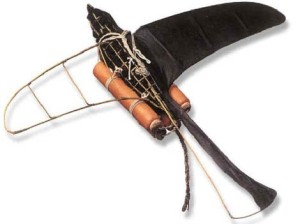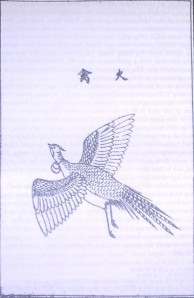Crow Bombs: Avian Missiles in the Medieval World November 9, 2010
Author: Beach Combing | in : Medieval , trackback Beachcombing has spent the last few hours enjoying a medieval work named the Book of Fires (Liber Ignium). The author’s alleged name, Mark the Greek is not certain and the text survives in Latin that means we cannot be certain either that it was originally written in Greek: though the structure of the Latin sentences would suggest that was indeed the case. It begins to appear in manuscripts from the 1400s onwards and if, as has been suggested, Albert the Great (obit 1280) and Roger Bacon (obit 1295) read the Book then it was clearly written prior to their compositions. Beachcombing can see no reason why it shouldn’t date back to, say, 800 or 700 A.D. but most scholars favour c. 1200 A.D. Beachcombing will avoid an unseemly cat fight over dates and just call it ‘medieval’.
Beachcombing has spent the last few hours enjoying a medieval work named the Book of Fires (Liber Ignium). The author’s alleged name, Mark the Greek is not certain and the text survives in Latin that means we cannot be certain either that it was originally written in Greek: though the structure of the Latin sentences would suggest that was indeed the case. It begins to appear in manuscripts from the 1400s onwards and if, as has been suggested, Albert the Great (obit 1280) and Roger Bacon (obit 1295) read the Book then it was clearly written prior to their compositions. Beachcombing can see no reason why it shouldn’t date back to, say, 800 or 700 A.D. but most scholars favour c. 1200 A.D. Beachcombing will avoid an unseemly cat fight over dates and just call it ‘medieval’.
‘Mark the Greek’ essentially put together a collection of recipes for fire-based weapons including descriptions of something that is gunpowder or at least something that is close to gunpowder. Beachcombing is going to shuffle by all of these – at least for today: and concentrate, instead, on paragraph three:
Alius modus ignis ad comburendos hostes ubique sitos. Recipe balsamum, oleum Aethiopiae, alkitran et oleum sulphuris. Haec quidem omnia in uase fictili reposita in fimo diebus XV subfodias. Quo inde extracto, coruos eodem perunguens ad hostilia loca sive tentoria destinabis. Oriente enim sole, ubicumque illud liquefactum fuerit, accendetur. Unde semper ante solis ortum aut post occasum ipsius praecipimus esse mittendos.
Another kind of fire for burning enemies wherever they are. Take petroleum, black petroleum, liquid pitch and oil of sulphur. Put all these in a pottery jar buried in horse manure for fifteen days. Take it out and smear the substance over crows which can be flown against enemy tents. When the sun comes up and before the heat has melted the liquid the mixture will inflame [on the crows]. But we suggest that this be used before sunrise or after sunset.
 Beachcombing sees that there are some sulky comments from medievalists trying to interpret ‘crows’, ‘coruos’ as missiles. But this won’t do. The point is surely that the bird, soaked in the mixture, roosts on the enemy tents and that, when the sun comes up, bursts into flames and sets the tents on fire as well. Beachcombing has not the slightest idea whether or not this is possible and will certainly not be carrying out any experiments on the crows of Little Snoring. Opinions though – as always would be most welcome: drbeachcombing AT yahoo DOT com
Beachcombing sees that there are some sulky comments from medievalists trying to interpret ‘crows’, ‘coruos’ as missiles. But this won’t do. The point is surely that the bird, soaked in the mixture, roosts on the enemy tents and that, when the sun comes up, bursts into flames and sets the tents on fire as well. Beachcombing has not the slightest idea whether or not this is possible and will certainly not be carrying out any experiments on the crows of Little Snoring. Opinions though – as always would be most welcome: drbeachcombing AT yahoo DOT com
Beachcombing has found some very vague references to the use of ‘avian missiles’ by the Arabs and Chinese.
With the Arabs he drew a complete blank.
However, with the Chinese he did stumble upon descriptions of avian-shaped projectiles (not, of course, the same thing) including an iron-beaked bird with its tail filled with incendiary and a bamboo fire bird with an open body filled with proto-gunpowder wrapped in paper. It is not clear to Beachcombing what these did: they date to the eleventh century.
More interesting, however, for present purposes, is a passage in Wu Ching Tsung Yao (aka Wujing Zongyao) (11) written in 1054 that describes birds and other ‘expendable’ animals having incendiaries attached to them. Beachcombing knows of no translation in English or, indeed, any other European language and so cannot read this for himself.
He has, thank the gods, stumbled on an illustration of said Chinese birds. Those poor darlings evidently did not come back…
For the ancient use of pig-missiles see this earlier Beachcombing post.
***
1 Dec 2010: Ostrich made a point about soaked birds that had passed slow Beachcombing by. ‘WRT the idea of ‘crows’ being used to carry an incendiary mixture against the enemy’s tents, I’m by no means a medievalist, nor even particularly fluent in Latin, but general knowledge about crows suggests that they’d be an unlikely means of carrying this stuff. To begin with, they’re not going to fly too well when they’ve been soaked in pitch. Crows will roost by preference in trees – tents don’t really provide good roosting places. They tend to be cautious of humans and their habitations, and that probably goes double if a human has just dipped them in pitch. Crows are also noisy, a poor choice of bird for what must surely be intended as a clandestine operation. I think some type of missile intended to be hurled from a distance is a much more likely candidate.’ When Beachcombing is next in his copyright library of choice he’ll spend some time in the medieval Latin dictionaries – such as they are. Thanks yet again to Ostrich!


